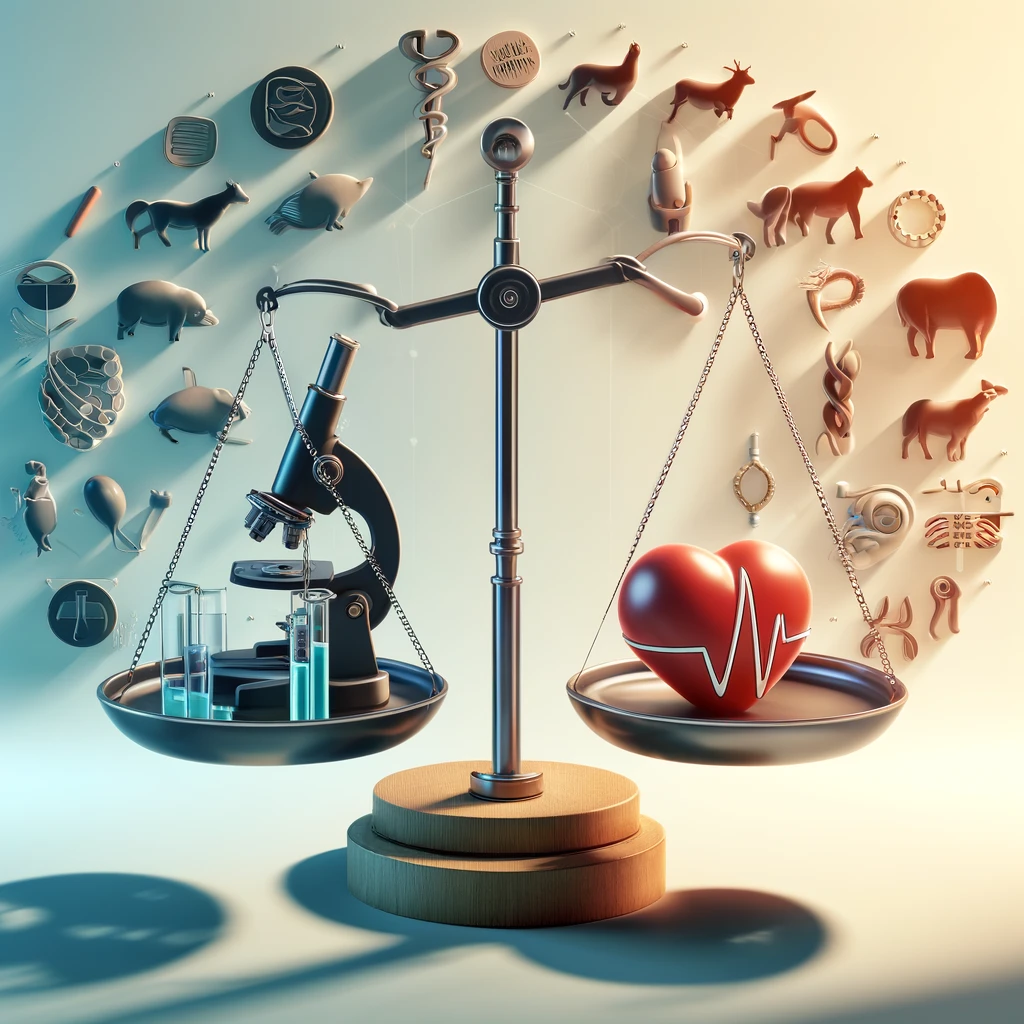
Understanding the Debate
Background
The practice of animal testing, also known as vivisection, has a long and complex history, dating back to ancient times. Greek physicians such as Aristotle and Erasistratus performed experiments on living animals to explore biological functions. Fast forward to the 19th and 20th centuries, animal testing became integral to the development of medical sciences, leading to critical discoveries like insulin for diabetes and vaccines for polio.
In modern times, the use of animals in research extends beyond medicine to include cosmetics testing, chemical safety assessments, and behavioural research. Despite technological advances, animals still play a role in scientific exploration due to their complex biological systems that often closely mimic those of humans.
Stakeholders
The debate around animal testing involves various stakeholders with differing perspectives:
- Scientists: Many argue that animal testing is essential for medical and scientific progress, providing invaluable insights that cannot be obtained from other models.
- Animal Rights Activists: Advocates for animal rights vehemently oppose animal testing, highlighting the ethical concerns and suffering inflicted on animals.
- Regulatory Bodies: Organizations like the FDA (Food and Drug Administration) in the United States mandate animal testing for drug safety and efficacy before human trials.
- The Public: Public opinion is diverse, with some supporting animal testing for its contributions to science and others opposing it on ethical grounds.
Scope
Globally, it’s estimated that tens of millions of animals are used in research and testing each year, including mice, rats, rabbits, primates, and dogs. The exact number is challenging to determine due to differences in reporting requirements between countries. The United States, for example, does not require labs to report the use of mice, rats, or birds, which constitute the majority of test subjects.
The Case for Animal Testing
Medical Advancements
Animal testing has been instrumental in numerous medical breakthroughs:
- Vaccines: Polio, measles, and hepatitis B vaccines were developed with the help of animal research.
- Treatments: Animal testing has contributed to the development of treatments for diseases such as diabetes, HIV/AIDS, and various cancers.
- Surgical Techniques: From organ transplants to heart surgery, animal models have been crucial in perfecting these life-saving procedures.
These achievements highlight the critical role animal testing has played in advancing human health and lifespan.
Regulatory Requirements
Laws and regulations in many countries mandate animal testing to ensure the safety and efficacy of new drugs and treatments. For instance, the FDA requires that pharmaceuticals undergo animal testing before proceeding to human clinical trials. This is to minimize human risk and understand the pharmacological profile of the substance, including its toxicity, pharmacokinetics, and potential side effects.
These regulatory frameworks are built on the premise that animal models can predict how humans might respond to new drugs, ensuring that only safe and effective treatments reach the market.
Scientific Necessity
There are situations where animal models are indispensable for understanding complex biological processes and diseases:
- Disease Models: Certain diseases can be studied in animals where naturally occurring or induced conditions mimic human diseases, providing insights into their progression and potential treatments.
- Drug Development: Animals are used to evaluate the pharmacokinetics of drugs – how they are absorbed, distributed, metabolized, and excreted by the body.
- Biological Complexity: Some biological and disease processes can only be studied in the context of a living organism, where the interplay of various systems can be observed.
Despite advancements in alternative research methods, such as computer models and cell cultures, these alternatives cannot yet fully replicate the complex interactions occurring within a living organism. Consequently, animal models remain a crucial, though controversial, element in scientific research and drug development.
The Ethical Standpoint Against Animal Testing
Moral Rights
The ethical argument against animal testing is deeply rooted in the belief in the intrinsic rights of animals. Central to this belief is the acknowledgment that animals, much like humans, have the capacity to feel pain and suffer, which raises significant moral concerns regarding their use in research. Philosophers and ethicists argue that subjecting animals to distress for the benefit of human knowledge or consumer safety is inherently unjust and disregards their welfare. This perspective champions the idea that animals have inherent value and rights that should be respected, challenging the notion of human superiority and the ethical permissibility of using animals as means to human ends.
Alternatives
In response to ethical concerns, there has been significant investment in the development of non-animal testing methods, which include:
- In Vitro Testing: Utilizing cell cultures to study biological processes and the effects of drugs and chemicals outside of a living organism.
- Computer Models and Simulations: Advanced algorithms and computer simulations that predict how substances might interact with biological systems.
- Human-Patient Simulators: Sophisticated mannequins and systems that mimic human responses and can be used for medical training and drug safety assessment.
These alternatives are not only ethically preferable but can also offer benefits such as lower costs and faster results. However, while significant progress has been made, these methods have yet to fully replace animal models in research due to limitations in replicating the complexity of living organisms.
Public Opinion
Public opinion on animal testing has shown a marked shift towards growing discomfort and opposition. Surveys and polls in various countries indicate an increasing percentage of the population questioning the morality of using animals in research, particularly in cosmetics testing and non-life-saving research. This shift is influencing consumer behavior, with a rising demand for products not tested on animals and greater support for companies investing in alternative testing methods.
Exploring the Grey Areas
Species Hierarchies
The debate on animal testing is further complicated by the differing moral statuses often assigned to various species. Primates, dogs, and cats, for instance, are frequently afforded higher moral consideration due to their perceived cognitive abilities and emotional complexity compared to rodents or fish. This hierarchy raises ethical questions about the basis and fairness of valuing one species’ welfare over another’s, challenging researchers to justify their choice of animal models and to consider the welfare implications more broadly.
Welfare Standards
The conditions under which animals are kept for testing purposes are a significant concern. While there are regulations in place intended to ensure humane treatment, such as the requirement for appropriate housing, nutrition, and veterinary care, reports of substandard conditions continue to emerge. These reports highlight issues like overcrowding, stress-inducing environments, and inadequate pain management, raising serious welfare concerns and questioning the enforcement and sufficiency of existing standards.
Regulatory Gaps
Inconsistencies and loopholes in animal welfare laws further complicate the ethical landscape of animal testing. For example, certain laws only apply to vertebrates, leaving invertebrates without any legal protection despite evidence of their ability to suffer. Additionally, some regulations exempt specific research areas or testing methods from stringent oversight, creating environments where animal welfare may be inadequately protected. The complexity of international laws and the variability in enforcement from one country to another only add to the challenge of ensuring the humane treatment of animals in research globally.
Case Studies
Success Stories
Animal testing has been a cornerstone in several medical breakthroughs that have significantly improved human health. One of the most notable examples is the development of the polio vaccine in the 1950s. Research involving non-human primates provided critical insights into the virus and its effects on the nervous system, leading to the creation of a vaccine that has nearly eradicated polio worldwide. Another example is the use of mice in cancer research, which has led to important discoveries about cancer genes and the development of targeted therapies, greatly improving the prognosis for many cancer patients.
Controversial Experiments
While animal testing has contributed to scientific advancements, it has also led to highly controversial experiments that sparked public debate and outcry. One such case is the psychological stress experiments on primates, intended to study depression and anxiety but criticized for their ethical implications and the extreme distress inflicted on the animals. Another example involves cosmetic testing, particularly the Draize eye irritancy test, where substances are applied to the eyes of restrained rabbits to assess irritation, causing widespread condemnation and leading to changes in cosmetic testing policies in several countries.
Alternatives in Action
The push for ethical research practices has led to the successful implementation of non-animal testing methods across various fields. For instance, the development of organ-on-a-chip technology, which mimics human organs on microchips, allows for detailed studies of organ interactions and drug effects without animal use. Another success story is the use of computer models in toxicology, where algorithms predict the toxicity of substances based on their chemical structure, significantly reducing the need for animal testing.
The Future Landscape
Technological Innovations
Emerging technologies are set to transform the landscape of biomedical research and reduce reliance on animal testing. Advances in tissue engineering have led to the creation of 3D-printed organs, offering new platforms for drug testing and disease modeling. Artificial intelligence and machine learning are also becoming integral in predicting drug interactions and toxicology, potentially bypassing the need for animal models.
Policy Trends
Recent years have seen a shift in laws and regulations towards reducing and refining animal testing. The European Union’s ban on the sale of cosmetics tested on animals and the adoption of the 3Rs principle (Replacement, Reduction, Refinement) in research protocols are indicative of this trend. Furthermore, regulatory agencies are increasingly accepting data from validated alternative methods, signaling a move away from animal-dependent testing.
Ethical Evolution
Societal values and ethics regarding animal testing are undoubtedly evolving. Increased public awareness and concern for animal welfare have led to greater scrutiny of animal research practices and a demand for transparency and accountability. This shift is not only influencing public policy and consumer behavior but also encouraging scientists and researchers to actively seek and develop alternatives to animal testing.
Engaging with the Issue
Getting Informed
To navigate the complex issue of animal testing, it is crucial for individuals to seek out reliable information and educate themselves on the scientific, ethical, and regulatory aspects. Understanding the nuances of the debate enables more informed discussions and decisions, whether as consumers, voters, or advocates.
Public Involvement
Individuals can play a significant role in the animal testing debate through various means. Supporting cruelty-free products and companies that invest in alternative testing methods can drive market changes. Engaging in public discourse, participating in awareness campaigns, and supporting animal welfare organizations are other ways to contribute to positive change.
Continued Dialogue
The continued evolution of the debate on animal testing underscores the need for ongoing dialogue among all stakeholders. Open discussions, ethical reviews, and collaborative research into alternatives are essential to balance the pursuit of scientific knowledge with ethical considerations. As societal values evolve, so too must our approaches to research, always striving for innovation that respects animal welfare and advances human knowledge.





